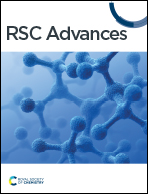An optical strategy for detecting hypochlorite in vitro and cells with high selectivity and stability based on a lanthanide-doped upconversion probe†
Abstract
The excessive use of sodium hypochlorite disinfectant for preventing COVID-19 can be harmful to the water environment and humans. More importantly, owing to hypochlorite being a biomarker of immune responses in living organisms, its abnormal production can damage nucleic acids and protein molecules, eventually causing many diseases (even cancer). Exploring a reliable, rapid, and non-invasive method to monitor the hypochlorite level in vitro and in cells can be significant. Herein, we report a novel ratiometric fluorescence sensing strategy based on Astrazon Brilliant Red 4G dye-sensitized NaGdF4:Yb3+, Er3+@NaYF4 core–shell upconversion nanoparticles (UCNPs@ABR 4G). Based on the combination mechanism of the fluorescent resonant energy transfer effect (FRET) and redox, a linear model of fluorescence intensity ratio and hypochlorite concentration was constructed for a fast response and high selectivity monitoring of hypochlorite in vitro and in vivo. The detection limit was calculated to be 0.39 μM. In addition, this sensing strategy possessed good stability and circularity, making it valuable both for the quantitative detection of hypochlorite in water and for the visualization of intracellular hypochlorite. The proposed optical probe is promising for the efficient and stable non-invasive detection of hypochlorite.



 Please wait while we load your content...
Please wait while we load your content...